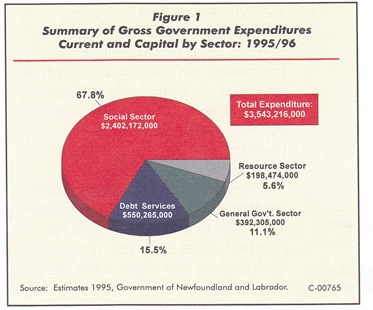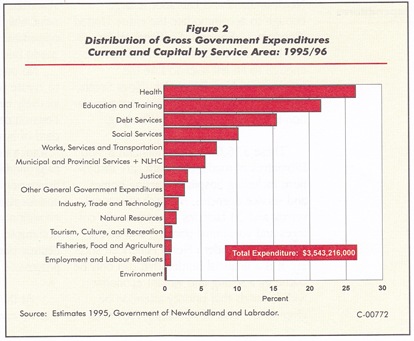In June 1992, the Government of Newfoundland and Labrador released Change and Challenge, the Province's Strategic Economic Plan. In the preparation of this document, involving an extensive public consultation process, it was stated repeatedly that economic planning was — in the words of Premier Wells — "only one half of the equation”. It was recognized that planning for the future development of the Province and the well-being of its people cannot be done on the basis of economic factors alone; it must embrace the social component as well.
This "other half of the equation" must reflect the needs of the people of Newfoundland and Labrador for more effective and equitable distribution of social services and benefits, improvement of educational levels, and progressive and innovative programs in health care and justice.
 Social planning is not a "necessary evil” which must be accommodated within economic activity. It is the hallmark of a caring, democratic society. However, it cannot be conducted in isolation, oblivious to the economic realities which dictate the extent of the fiscal resources which are available to provide the social services that are needed.
Social planning is not a "necessary evil” which must be accommodated within economic activity. It is the hallmark of a caring, democratic society. However, it cannot be conducted in isolation, oblivious to the economic realities which dictate the extent of the fiscal resources which are available to provide the social services that are needed.
Indeed the sheer weight of Provincial social spending demands that programs be carefully examined and prioritized, or the economy will be unable to sustain them. In the current Provincial budget of over $3.5 billion, 67.8 percent ($2,402172,000) will be spent in the social sector as compared to 5.6 percent ($198,474,000) in economic development (see Figure 1 and 2) The combined expenditure of the Departments of Industry, Trade and Technology, Natural Resources, Tourism, Culture and Recreation, Fisheries, Food and Agriculture, and Environment are less than 55 percent of the cost of the Department of Social Services alone, and little more than one-fifth the cost of health care in the Province.
 These costs have been more than the Province's tax base can bear, and consequently the direct Provincial debt has increased almost every year since Confederation until it now totals more than $6 billion and costs more than $540 million a year to service. The problem of serving a small population in more than 700 communities scattered over a large land-mass becomes clear when compared to other geographic and demographic indicators.
These costs have been more than the Province's tax base can bear, and consequently the direct Provincial debt has increased almost every year since Confederation until it now totals more than $6 billion and costs more than $540 million a year to service. The problem of serving a small population in more than 700 communities scattered over a large land-mass becomes clear when compared to other geographic and demographic indicators.
For example, the Province of Newfoundland and Labrador is large enough to accommodate the entire United Kingdom — England, Scotland, Wales, and Northern Ireland — and still have enough room left over to take the provinces of New Brunswick, Nova Scotia, and Prince Edward Island. Yet, our population is less than the city of Winnipeg.
These 576,000 souls maintain 8,900 kilometres of roads, 67 heath care institutions including hospitals, nursing homes and service agencies, 476 schools, a university and 23 facilities for community colleges and vocational training, and all the trappings of modern North American society. It is a financial burden that can only be borne by a strong and vibrant economy, and demands that priority attention be given to the task of increasing Provincial
revenues through stimulating new and existing enterprises. Without private sector business growth, we cannot survive as a province. At the same time, social services and facilities must be operated as efficiently as possible without sacrificing essential programs for health, education, and public safety.
Obviously, economic and social planning are inextricably linked. But they must be linked in support of each other, not in conflict or competition. They must be partners, not adversaries, and a viable economy and effective social system both depend on a healthy and sustainable environment. The three together constitute our human ecosystem. The simple fact is that in the everyday living of Newfoundlanders and Labradorians, social and economic factors merge into one single, simple priority: Quality of Life. Whether wealthy or impoverished, people share the same needs for health, happiness, enlightenment, security, freedom, opportunity, and community.
No one living in this Province wishes to create wealth either individually or collectively by wreaking third-world conditions on our physical environment or standard of living. The collapse of our basic resource industry through the devastation of groundfish stocks through foreign over-fishing, errors in resource management, and local over-production has demonstrated with a vengeance that it profits us nothing to gain short-term prosperity if we destroy our long-term resources in the process.
At the same time, no one will dispute that we cannot maintain our quality of life without a stronger economic base. In other words, we cannot build a vibrant economy without a strong social structure; neither can we maintain vital social support programs nor preserve our culture and quality of life without strong economic growth.
Accordingly, on March 4, 1993 the Throne Speech in the House of Assembly committed Government to continue its planning process with the development of a Strategic Social Plan as the essential and equal partner to the successful and highly-acclaimed economic plan. A Strategic Social Planning Committee of senior officials was established immediately, and work began on the first phase of the process, i.e., the initial task of reviewing all Government social programs and policies, studying emerging social trends locally and globally, collecting and analyzing data, and preparing discussion papers for Cabinet consideration. The result of that activity is this Consultation Paper which is offered for public consideration, discussion, and commentary in the second phase of the process.
As in the case of the Strategic Economic Plan, the public consultation will be conducted independently of Government to provide opportunity for objective and effective participation by the widest possible representation of the general public. The input of the people who participate in this process will be incorporated into the third phase of the process: the development, release and implementation of the completed Provincial Strategic Social Plan.
-srbp-
Next: Background – Social Profile